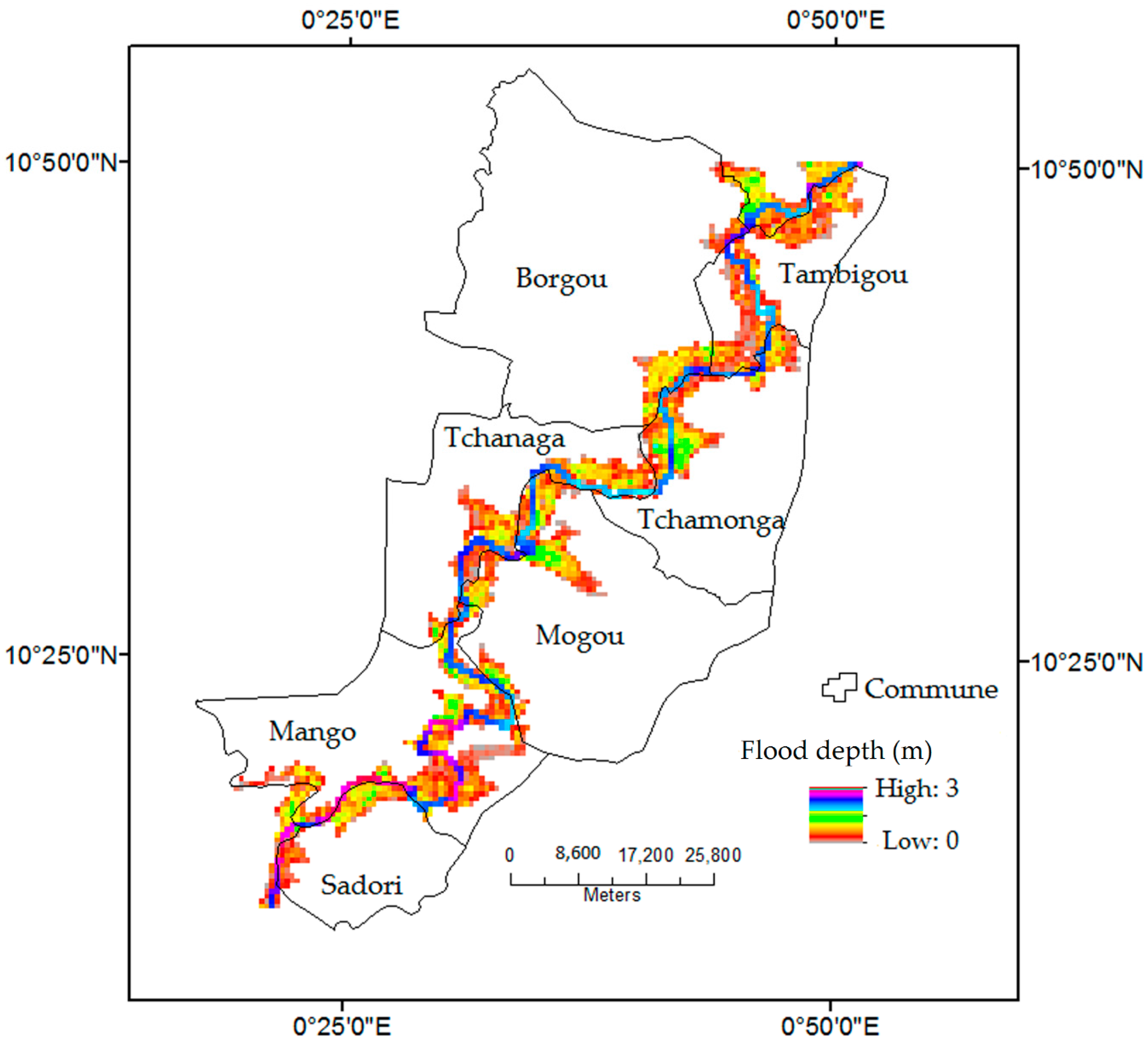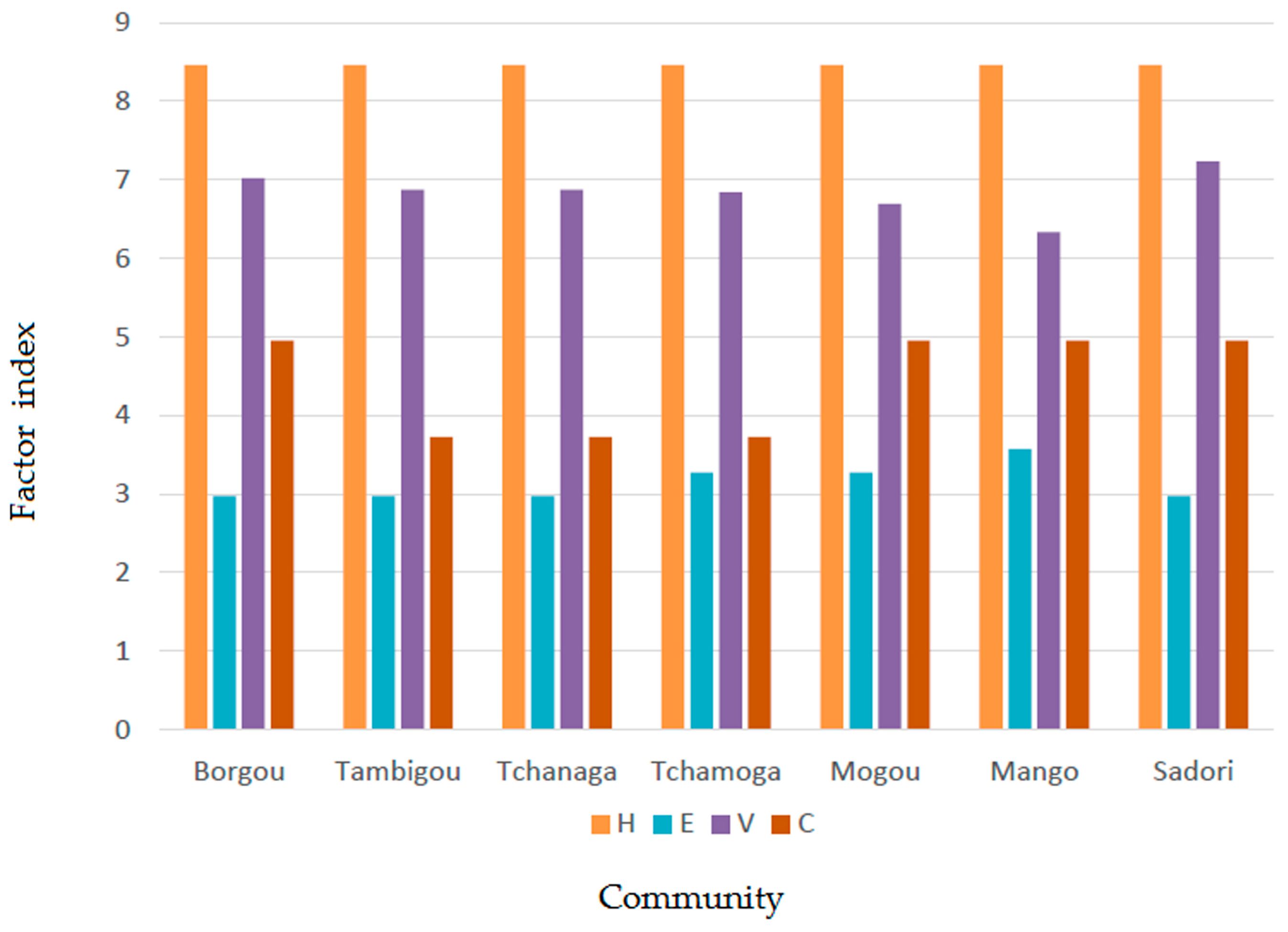1. Introduction
In many parts of the world, extreme floods have been observed and grave consequences on ecosystems, human life and socio-economic activities have been reported. In the last two decades, floods have caused extensive economic damage and loss of life throughout the world. For instance, floods in September 2007 in West Africa caused 23, 46 and 56 deaths in Togo, Burkina Faso and Ghana, respectively [
1] and extraordinary floods occurred in 2010 in Pakistan and China [
2]. Apart from the effects of human-induced climate change, which is expected to exacerbate this dire situation, many factors contribute to Africa’s high vulnerability to disasters, including a high rate of population growth, high levels of poverty, inappropriate use of natural resources, and failures of policy and institutional frameworks [
3]. In addition, the main features that characterize an area vulnerable to flood hazards are the flat topography, the geological conditions, urbanization and poor draining networks [
4]. Managing flood risk is important to reduce the damage and adapt to the combined effects of climate and land use changes. With risk defined herein as the probability of harmful consequences, or expected losses and resulting from the interactions between natural or human-induced hazards and vulnerable conditions [
5], flood risk can then be managed by reducing the hazard (probability or magnitude) or by reducing the vulnerability of the exposed population.
This approach to managing flood risk is based on the knowledge of the hazards and the physical, social, economic and environmental vulnerabilities to floods that a population faces. Consequently, efficient flood risk management is reliant on a priori assessment of flood hazards. Such assessments give insights into what can be expected, and therefore open up the discussion on how to tackle such situations [
6]. Moreover, flood hazard assessment is indispensable for the development of policies and plans to mitigate flood risk [
7]. A risk assessment is a methodology to determine the nature and extent of risk by analyzing potential hazards and evaluating existing conditions of vulnerability that could pose a potential threat or harm to people, property, livelihoods and the environment on which they depend [
5]. Depending on data availability, the scale of application and the purpose of the risk assessment, several methods have been used to assess flood risk over the last decades. For instance, Ward et al. [
8] developed and validated a model cascade to assess flood risk at the global scale. The cascade included hydrological and hydraulic modelling, extreme value statistics and estimation of annual expected impacts. Because of the small time required for the simulations and the good performance of the model cascade, the authors conclude that it could be used to carry out assessment of changes in flood risk. Remote sensing and Geographic Information System (GIS) were used for the delineation of flood zones for flood risk analysis in Ghana [
9]. Musungu et al. [
10] proposed a methodology of integration of community-based information into a GIS for flood risk assessment of an informal settlement in Cape Town (Republic of South Africa) and Guarín [
11] integrated local knowledge into GIS-based flood risk assessment of Triangulo and Mabolo communities in Naga city (Philippines). A Community-Based Disaster Risk Index (CBDRI) approach, developed by Bollin et al. [
12], was applied by Adeloye et al. [
13] to assess flood risk and vulnerability of rural communities in Malawi (South Africa) and the German Technical Cooperation Agency (GTZ) to assess disaster risks in Africa, Asia, Caribbean, Central America and South America [
14]. The CBDRI model was chosen in this study because it can be applied in data sparse areas where data for conventional flood risk assessment are missing.
Traditionally, flood risk is expressed in terms of expected damages and likelihood of occurrence. The flood damage is combined with information on the probability of the flood event and then plotted as return period-damage curve [
15,
16]. However, the results obtained using this method would provide neither sufficient information nor the required level of detail for input into flood risk reduction strategies. In addition, the use of damages to assess flood risk suffers from data scarcity, particularly in developing countries where data are usually scarce. The reason is that disaster-related damage figures are not systematically recorded and are often under-recorded, even in developed countries [
17,
18]. According to Birkmann [
17], highly exposed regions, with high poverty levels and subject to repeated and catastrophic floods, may not necessarily register significant deaths or damage, although these factors make such places highly risky. Moreover, since mortality and damage figures are obtained from actual events, the use of damage assesses actual vulnerability but potential vulnerability is ignored [
18].
This study aims at assessing fluvial flood risk of seven rural communities in the study area. Specifically, three research questions are investigated: (i) what are the major factors that contribute to flood in the studied communities? (ii) what are the level of flood risk in the Oti River Basin? and (iii) what type of measures are required to reduce flood risk in the basin?
This study performs an integrated flood risk assessment for rural communities of the Oti River Basin in Togo, West Africa. This is important because this basin is subject to frequent flooding, and it is the first time to analyze flood risk in this area. This methodology can be used to support decision-making on possible measures that can be taken and to prioritize areas where actions are required.
4. Discussion
In the present work, a community based disaster risk index system and a simulated 50-year flood hazard map were used to assess quantitatively and qualitatively flood risk for rural communities of the Oti River Basin in Togo (West Africa). Thirty seven (37) indicators of flood risk were considered for the analysis and Saaty’s AHP (analytical hierarchy process) method was applied to estimate the weights of the indicators.
The results showed that the hazard, vulnerability, coping capacity factors are the most important factors in increasing flood risk in the study area. For instance, as shown in
Figure 3, the hazard and vulnerability indices are high in all the studied communities. The low index of capacity and measures factor is associated with the insufficiency of the strategies and capacity to mitigate flood risk. For instance, the people interviewed pointed out the absence of flood risk management committees at the village level, non-access to local emergency funds and insurances for house owners. In addition, education and culture of flood risk management are not part of the school curricula. Apart from Sadori, Mango and Borgou, the investigated communities lack early warning systems and emergency plans for floods, although advanced warning systems for floods are very helpful in reducing flood risk and providing emergency response personnel time to prepare for and mitigate damages [
39,
40]. Consequently, decreasing vulnerability and increasing capacity of the communities to manage their own flood risk should be paramount in order to mitigate flood risk in the study area. For instance, due to the high poverty level in the majority of the community areas (
Table 1), creating diverse income-generating opportunities could be essential to reduce the vulnerability of the local population. The results of this study showed the need for non-structural measures to reduce the negative consequences of floods in the study area. These measures include the implementation of advanced early flood warning systems for all the flood-prone communes and public education about flood risk, real involvement of wide range of local actors in national efforts to manage flood risks so that they can contribute as much as possible to the reduction of flood risks in their own localities, and a creation of a culture of awareness in which the population realises the negative impacts of floods on development. Moreover, actions to discourage settlements in flood-prone areas and building codes to make houses more resilient to flooding are useful to mitigate flood risk in the Oti River Basin.
Furthermore, the relative homogeneity observed in the majority of the vulnerability and coping capacity is reasonable because the studied communities are almost the same in their social and economic profiles as shown by their poverty levels (
Table 1). In addition, their economic capacities for disaster risk management are also the same: all are funded by non-governmental organisation in the case of flood disasters. They are managed at the top by a central government (lack of decentralization). For this reason, a large difference in vulnerability and capacities in the Oti River Basin at the village scale is unexpected.
The presented flood risk indices summarize complex information about flood risk in a simple way that is easy for non-experts to understand and use in flood risk management policies [
12]. However, there are some issues that need to be considered. First, the majority of the data are subjective as they were collected from selected local residents. In addition, the results are dependent on the selected indicators, their categorization, the set of thresholds and the spatial scale of application. Second, the selected indicators are only a simplification of key elements of flood risks and vulnerabilities that we wanted to measure. They are not real measures of these elements themselves. Finally, the return period associated with the simulated flood hazard severity is 50 years. Given the significant contribution of the hazard factor to the total flood risk, the results will differ if floods with lower or higher return periods than 50 years are considered.









